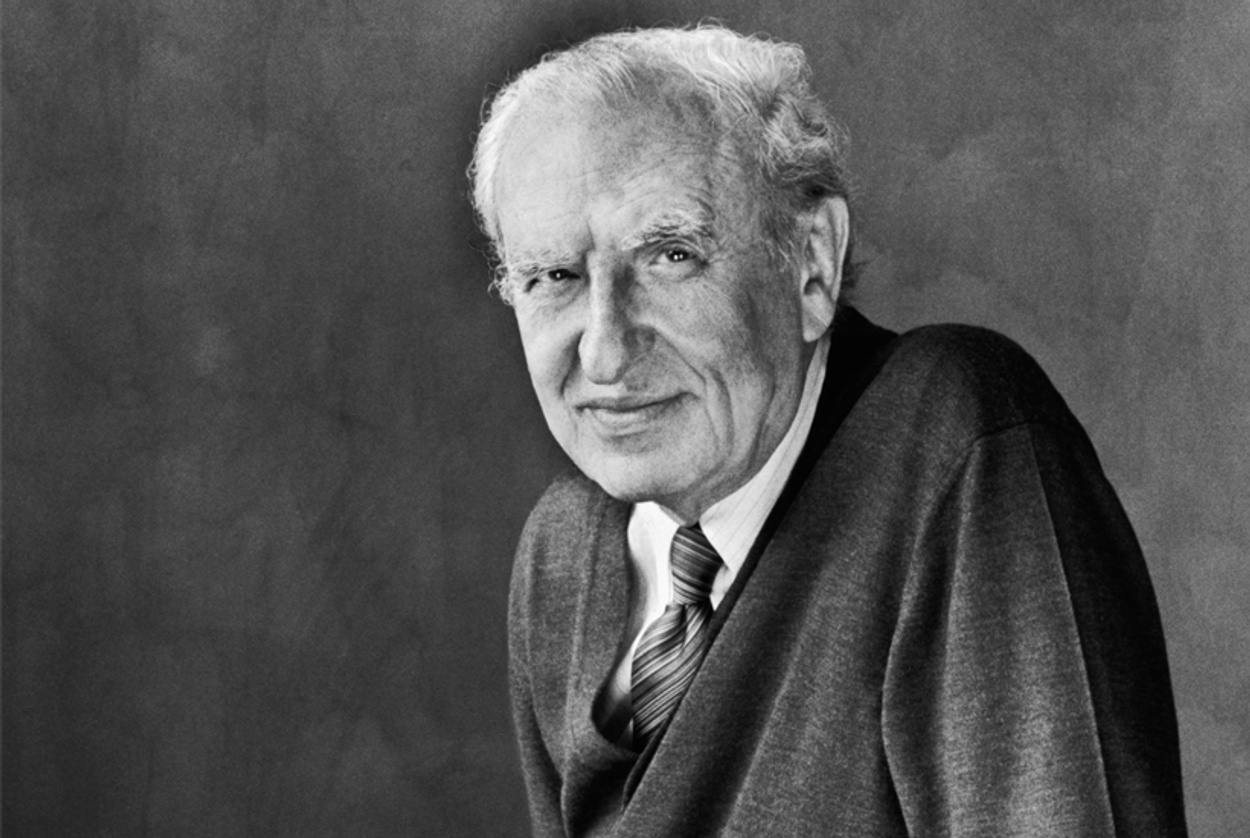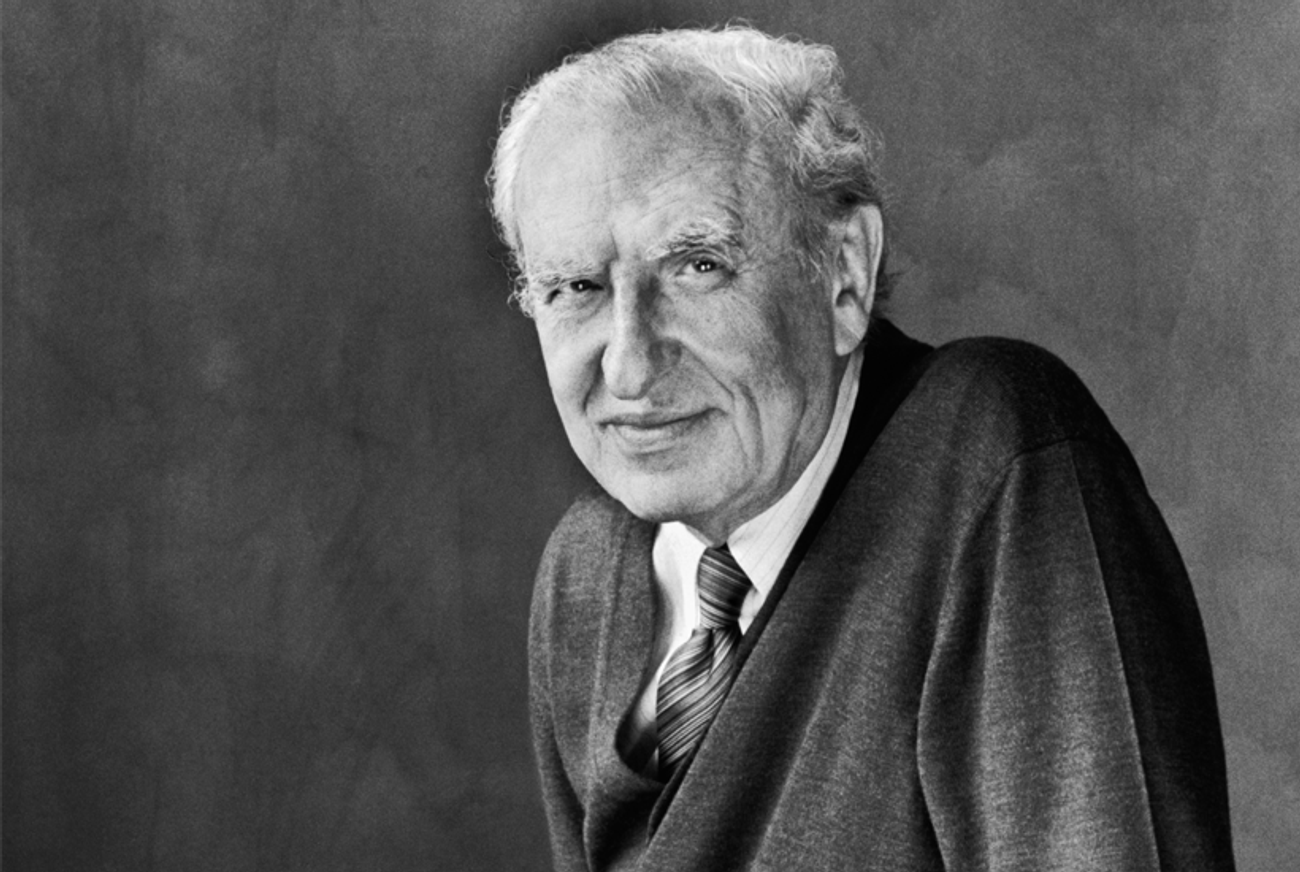Remembering Arthur Gelb, Who Helped Reconcile the ‘Times’ to Its Jewishness
While the Sulzbergers tiptoed around their ethnic identity, Gelb knew America meant Jews could have both O’Neill and egg creams




Early one afternoon during the fall of 1981, as a quaking 26-year-old, I rode the elevator up from the lobby of the New York Times building to the 10th floor, heading for the executive dining room where I was to meet Arthur Gelb for the first time. I was being considered for a reporting job on the paper, though the available slot was writing how-to articles for the Home section, a total departure from my background covering education, local politics, and the arts. Even so, I was determined to prove my worthiness to the Times in whatever position was open.
Besides, the interview gave me a chance to talk to the great Gelb about an even greater hero of mine: the playwright Eugene O’Neill. Back in high school, I had read the sweeping, authoritative biography of O’Neill done by Arthur and his wife Barbara. So, after I ordered vodka on the rocks to settle my nerves, and was reassured when Arthur chose the same drink, we dove into O’Neill, with Arthur offering first-person accounts of José Quintero, Jason Robards, and Colleen Dewhurst from the legendary 1973 revival of A Moon for the Misbegotten.
Somehow, though, we also wound up on the subject of egg creams. It wasn’t the topic I’d been expecting from the Times’ deputy managing editor, the right-hand man to Executive Editor A.M. Rosenthal. Warily, fearful of any disqualifying gaffe, I told Arthur I thought the best egg cream around was served at Dave’s, a linoleum-tile and fluorescent lighting sort of luncheonette on Canal Street. (Keep in mind this is the decrepit Canal Street of a New York City still staggering back to its feet from near-bankruptcy six years earlier.) To my surprise, not only did Arthur the aesthete know of Dave’s, but he concurred in my evaluation of its egg creams. Who knows—maybe that’s why I got hired, thankfully for a position on the Metro desk.
I have thought a lot about that first lunch with Arthur in the days since he died on May 20, at age 90. The way he could effortlessly swivel from O’Neill to egg creams, passionate and knowledgeable about both, says a great to deal to me about his importance to the New York Times. Sam Roberts’ superb obituary for Arthur in the Times, and many of the subsequent obits and tributes, have understandably extolled Arthur for his fervent intellect, his talent-scouting, his mentoring, and those vast pterodactyl arms, flapping with any given nanosecond’s brainstorm.
All of those assessments are true. Yet I want to add a different element to history’s judgment of Arthur Gelb. Along with Abe Rosenthal, he helped to reconcile the New York Times to its Jewish identity; he helped absolve it of the tormented guilt and self-abnegation that plagued it on all matters Jewish.
***
To say that the Times is a Jewish newspaper is to state a fact, since it was founded and owned by Jews, the Ochs-Sulzberger lineage. To say it, though, is also to invite the usual canards about Jewish control of the media, to risk resurrecting those slurs about “The Jew York Times” or the sly, cunning way “Times” could be read backward as “Semite.”
Mindful of such anti-Semitism, the Sulzbergers of the 20th century over-corrected. Their newspaper opposed Zionism, downplayed the Jewish essence of the Holocaust, and ordered editors to replace phrases such as “the Jewish people” with the anodyne “people of the Jewish faith.” Over the generations, the Sulzbergers migrated from the Reform Judaism of their German heritage, which itself exuded ambivalence about being Jewish, to conversion into the Episcopalian church. Times journalists who were named Abraham—as in Abe Rosenthal and labor reporter Abe Raskin—were mandated to use their ethnic-neutral initials, A.M. and A.H., respectively, in their bylines. For decades after Israel was founded, unofficial Times policy forbade a Jew from covering that beat.
Choosing their own words delicately, Susan E. Tifft and Alex S. Jones write in The Trust, their biography of the Ochs-Sulzberger dynasty, that Arthur Hays Sulzberger, grandfather of the present publisher, “felt the Times had to ‘lean over backwards’ to be objective and balanced about Jews.” Tifft and Jones also quote Sulzberger’s daughter Judith saying, “Deep down, my father probably would just as soon not have been Jewish.”
Starting on the Times during World War II, a City College dropout working as a copy boy, Gelb quickly grew distressed at the institutional timidity, especially in the Times’ reporting about the Nazi death camps. “It was as though the top editors, in the beginning at least, simply could not bring themselves to entirely accept the reports filed by seasoned war correspondents,” Gelb recalled in his memoir, City Room. “Since the stories tended to describe the liberated inmates as ‘victims’ and ‘prisoners,’ rarely as ‘Jews,’ many of us in the city room simply couldn’t fathom what was in the mind of our editors.”
The Times’ contortions about anything Jewish were reflected in personal choices, as well. Its top editors were often quintessential Southern Christian gentlemen—Turner Catledge, Clifton Daniel. Many of the paper’s Jews in Arthur Gelb’s generation felt driven to efface any remnant of ghetto and shtetl, sometimes by Anglicizing one’s name, sometimes by remaking one’s manner. When I started on the Times in the 1980s, I sometimes heard the story of Sydney Gruson, a foreign correspondent who went on to become a Times executive as well as a close personal friend of then-publisher Arthur “Punch” Sulzberger.
Gruson had grown up nearly destitute, starting to work as a bellhop at age 12. Yet the man I saw was all bespoke elegance. Supposedly, Gruson once said that his life’s ambition was to be “the ultimate weekend guest.” Even if apocryphal, that comment evokes a larger truth about a Jewish presumption in mid-century of what getting ahead required.
Which brings me back to the egg cream. Arthur Gelb was part of that wave of lower-class immigrant Jewry from Eastern Europe, the American-born child of parents from what is now Ukraine. His mother ran a dress shop out of the family’s East Harlem home. He went to public high school and then to City College, sometimes called “the Jewish Harvard,” before eventually getting his degree from N.Y.U. At the Times, in his times, Arthur had a common enough mutt’s pedigree; what was uncommon was his comfort with it.
As far as I ever knew, Arthur had no religious feeling for Judaism, and yet he felt a soul-deep identity as a Jew. Instead of being ashamed of his past—the scrappy kid from the crummy neighborhood—he defined himself by it. His ardor for all forms of culture was consistent with a broader ideal among Jewish immigrants that music, painting, theater, and so on were as much the province of the poor as of the entitled. For that generation, art was a means of auto-emancipation. To be more specific, many of the journalists and artists whom Arthur discovered and championed had lived very similar versions of his journey; either literally or metaphorically, they were the outer-borough Jew making his or her way to the promised land of Manhattan without becoming deracinated in the process.
Two years into my stint as a Metro reporter, Arthur summoned me back to the executive dining room to be informed I would now be covering the theater beat. He had not, it turns out, forgotten our chat about O’Neill and my love of theater. Still, covering that beat for the paper of record daunted me. So, Arthur gave me a reading list to prepare for the assignment. One of the books on it was Act One, Moss Hart’s memoir of his odyssey from impoverished childhood in Brooklyn and the Bronx to Broadway acclaim as a playwright and director. I realize now that Arthur was, in a sense, handing me his own autobiography.
So, it makes perfect sense to me that Arthur connected so strongly to cultural figures like filmmaker Woody Allen, singer Barbra Streisand, novelist Joseph Heller, director Mike Nichols, theater impresario Joseph Papp, opera diva Beverly Sills, painter Tobi Kahn. Every single one of them followed some version of the life path of Arthur himself. Nor does it seem to me at all accidental that two of the journalists Arthur most intensively nurtured, Frank Rich and Maureen Dowd, were the Washington, D.C., version of the bridge-and-tunnel crowd, middle-class townies removed from the capital’s elite.
In his politics, too, Arthur was a Jew of his time and place. He struck me as something like the original, non-pejorative definition of a neo-conservative: someone who is a New Deal liberal on domestic issues and a Cold War hawk on foreign affairs. One of the cherished objects in Arthur’s office was a photo of himself with Elie Wiesel in Red Square, during a trip when Wiesel imbued Gelb with the story of Soviet Jewry. Arthur’s political sensibility led him (and Abe Rosenthal) into the most serious mistake of his career, publishing a lengthy defense of novelist Jerzy Kosinski after the Village Voice had raised what proved to be accurate doubts about his putative memoir, The Painted Bird. Still, that decision is just one blemish in a long, illustrious career.
Maybe the greatest testament to what Gelb accomplished at the Times is that the battles he implicitly or explicitly fought—against inherited privilege, against Jewish self-hate, against any elitism except the elitism of artistic brilliance—seem distant now. On second thought, perhaps not entirely. Arthur Gelb may have had little use for identity politics in the left-wing meaning of the term, but by his example he showed the value and virtue of being at home within your own skin.
***
Like this article? Sign up for our Daily Digest to get Tablet Magazine’s new content in your inbox each morning.
Samuel G. Freedman is a journalism professor at Columbia University and a regular contributor to Tablet. He also writes the “On Religion” column for The New York Times.
Samuel G. Freedman is a journalism professor at Columbia University and a regular contributor to Tablet. He also writes the “On Religion” column for The New York Times.